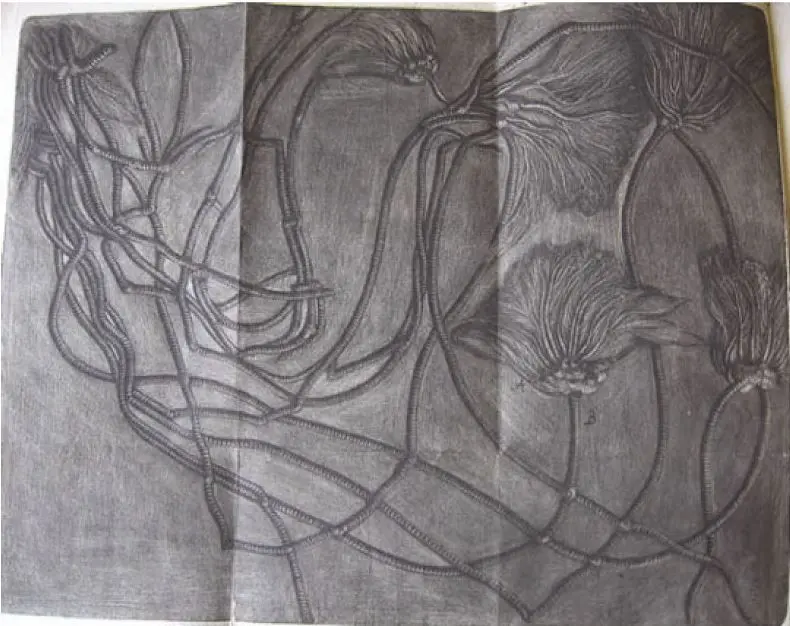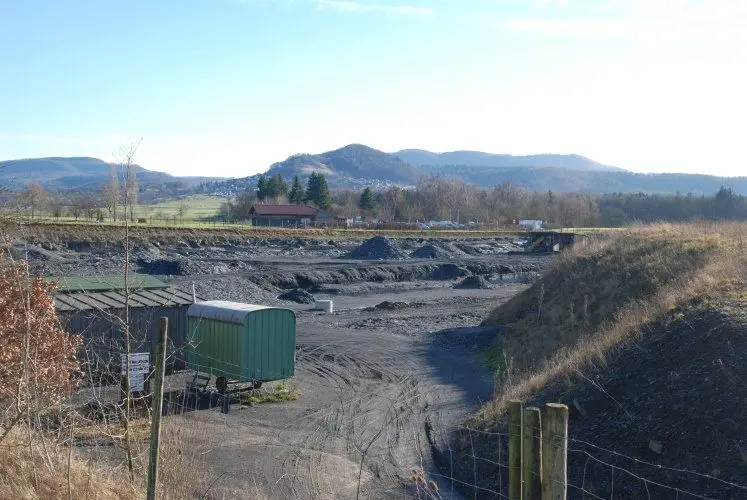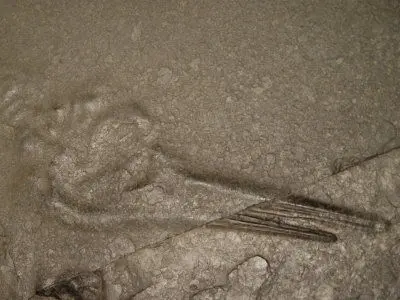The Posidonia shale from the area around Holzmaden is famous for his fossils. One of the first fossil collectors at all was Duke Carl Eugen of Württemberg so documented in 1749. When Bernhard Hauff, the legendary preparator, uncovered extremely fine, coal-black remnants while preparing an ichthyosaur in 1892, it was the first time that fossil remnants of soft tissue were detected. Since then, the march of fossils from Holzmaden into the museums worldwide started.

The fossils give insight into the habitat of a shelf sea that existed in Central Europe about 180 million years ago.
Besides perfectly preserved skeletons of vertebrates, echinoderms, crustaceans and the shells of molluscs, remains of the soft bodies with skin impressions and organ remains are also preserved.

When Bernhard Hauff, the legendary fossil preparator, uncovered extremely fine, coal-black remains of an Ichthyosaur and explained this as preserving skin, this was initially declared impossible by Prof. Oskar Fraas. In fact, it was the first time that fossil soft tissue remnants had been dicovered. The triumph of Holzmaden fossils in museums around the world has started.
The knowledge about the special fossils have been common for a long time. In 1598 J. Bauhin reported on findings from Bad Boll. In 1724 a finding in Ohmden caused a sensation, which E. Hiemer addressed as follows:
"The head of Medusa, a new testimony to the universal flood, discovered in the Württemberg ground."

Unlike previously findings of fragmentary pieces, this completely recovered fossil allowed a determination for sure. And indeed, Hiemer compared the finding with the Caput Medusae, an echinoderm from the Indian Ocean that became famous in 1705. He had no doubt, this animal made its way to Württemberg by a great flood.
Fossil trading goes back to Duke Carl Eugen von Württemberg. In 1749 he gave the order to deliver important fossils for teaching purposes to Stuttgart for a premium.

Among them was an Ichthyosaur fragment with an embryo in its body - the oldest dinosaur found in Central Europe. Often embryos are embedded in a black, organic substance that is recognizable as a fossil amniotic sac.
In 1970 the term "Lagerstaette" was defined based on studies of the Holzmaden fossil site: "Fossil deposits are bodies of rock that contain an unusual amount of paleontological information in terms of quality and quantity"" (Seilacher 1970).

Even if the “golden” days of manual mining passed and only a few findings are being recovered, the Holzmaden area is good for surprises, thanks in part to more refined preparation methods. Nowhere else in the world are vertebrates found in this quality and frequency.
You are invited to support efforts to recognize Holzmaden as UNESCO-Heritage Site. Get inspired by the fascinated fossils and visit one of the museums!


Recent studies have shown: The climate was characterized by summer monsoons and winter drought by trade winds, which caused strong seasonal fluctuations in the oxygen content in seawater. Therefore, dead tissue decomposed very slowly. The dead animals were soon covered and preserved by the clays and limestone that were washed in. The mud solidified over the course of millions of years. The change of seasons in the Jurassic Sea turned into a petrified sequence of layers.

Slate quarries around Holzmaden have been in operation at least since the Medieval times. Quarrying was always focussed on the so-called Fleins, a layer of only eighteen centimeters thickness. The Fleins usually splits twice. Its beautiful rough surface, which is covered over and over with Posidonia shells, is used for interior design purposes. The slate quarries used to be generally five by eight meter pits, the mining of which was carried out in the manner of the wandering quarry, in that the exploited part of the pit was filled with the overburden from the quarry section. Today, almost the entire area around Holzmaden, where the Fleins was between two and four meters below the surface, has been exploited. The slate quarries have all moved to areas where the Fleins is up to ten meters deep and can only be reached using heavy machinery.


Depending on the layer and location, the slate contains up to twenty percent organic matter and therefore burns. The bitumen is extracted by dry distillation and three to seven percent oil is obtained. On the quarry area near Holzmaden, large fires have repeatedly broken out due to inattention: “In 1668 a slate quarry at Boll caught fire. Nobody knew how to fight off the fire. During the six-year fire, oil flowed out of the ground, which people sold as rock oil" (O. Fraas). Oil and tar from Posidonia Shale were used in the pharmaceutical industry.
Nowadays the two quarrys left around Holzmaden reveal the "Fleins" a depth of approx. 12 m. Over 90% of all vertebrate and sea lily findings are limited to this fund-rich horizon - with the exception of the crocodiles, which are found in the "Untere Stein".
The fossils were always only "ad on" to usual business, because profit of hunting fossils was not worth quarrying. In 1939 around 30 quarries with over 100 stone crushers were in operation in the area around Holzmaden, but mining has now almost completely stopped.
The situation is somewhat different in Dotternhausen near Balingen, where oil shale has been quarried since 1939. The Holcim company uses the oil shale either for clinker production or as a raw material for Portland shale cements. Here mining extends to the Fleins at a depth of approx. 8 m. The material (300t / h) is extracted by blasting and then moved to the mobile crusher.

The "Lower Shale", also known as "Oil Seam", supplies a maximum of 8% crude oil. This gave rise to repeated attempts at oil exploitation. The Jura oil slate factory was built near Göppingen during World War I. Towards the end of World War II, a desperate attempt was made to obtain mineral oil for tanks and airplanes. More than 3,480 people fell victim to the so-called "Desert" operation in the concentration camp KZ Bisingen near Balingen.
A trained eye is required to discover the fossils. Usually nothing of the fossil is visible on the surface of the rock, apart from at most a flat bulge. Only in the transverse fracture bones can be recognized by their brown color in gray slate. It is now the task of the skilled person to determine the type, size and position of the fossilization at the transverse fractures and to join piece by piece of the slate slate, which is often often broken up.

Photo showing legend Bernhard Hauff while excavation of an Ichthyosaur, part of a Reprint dedicated to his 150 Birthay..

